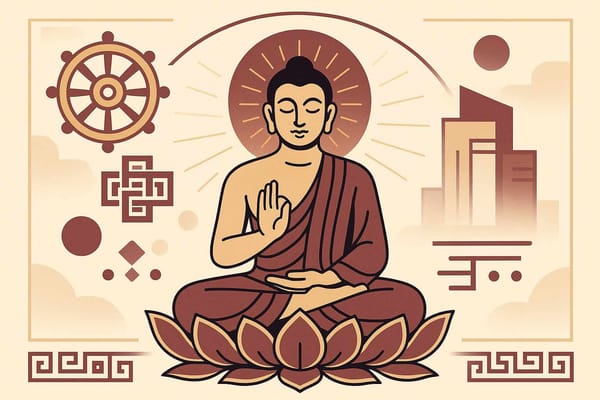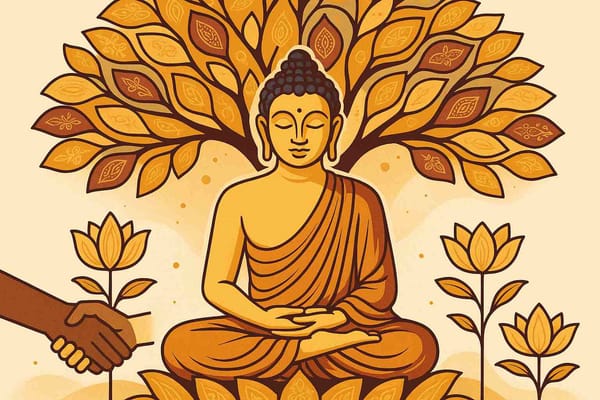
Navayana: A Modern Perspective on Buddhism - Explained
Have you ever wondered if spirituality could do more than just soothe the soul? What if it could heal society itself? This very powerful idea is at the heart of Navayana Buddhism, a modern path that re-imagines ancient wisdom to fight for equality and justice in our world. It's a journey that began not in a quiet monastery, but in the midst of a struggle for human dignity, led by the great Dr. B.R. Ambedkar.
For many of us, spirituality is a personal journey inwards. But Navayana, which beautifully translates to the "New Vehicle," turns this idea outwards. It asks us to use our spiritual understanding to build a better, fairer society for everyone. Let’s explore this unique path that continues to inspire millions in India and beyond.
The Birth of a Movement: Why Dr. Ambedkar Chose a New Path
To truly understand Navayana, we must understand the life and vision of its founder, Dr. B.R. Ambedkar. As the architect of our Constitution, he was a man of profound intellect and deep compassion. Having experienced the painful reality of caste discrimination firsthand, he sought a spiritual home that offered not just solace, but also self-respect and equality.
He found that home in the teachings of the Buddha, but with a revolutionary re-interpretation. For him, Buddhism was not about metaphysical concepts or complex rituals. It was a rational, ethical, and practical guide to living a moral life and creating a just society. This led to a historic moment on October 14, 1956, a day now celebrated as Dhammachakra Pravartan Day, when Dr. Ambedkar and nearly 380,000 of his followers embraced this new vision of Buddhism.
So, Navayana isn't just a branch of Buddhism; it is a powerful social and spiritual movement born from the need to restore dignity to those who had been denied it for centuries.
Navayana and Traditional Buddhism: Understanding the Key Differences
Many of us are familiar with the core ideas of traditional Buddhism, like karma, rebirth, and meditation for individual enlightenment. Navayana respectfully charts a different course, focusing on what it considers the core, practical message of the Buddha.
The main question Navayana addresses is how it differs from traditional schools like Theravada or Mahayana. The answer lies in its focus. While traditional paths often emphasize personal liberation from the cycle of birth and death (samsara), Navayana prioritizes social liberation from oppression in this lifetime.
Here’s how it re-imagines some core concepts:
- Rejection of Karma and Rebirth: Dr. Ambedkar felt that concepts like karma and rebirth were often misinterpreted to justify the caste system—implying that one's social standing was a result of past actions. Navayana sets aside these ideas to ensure that no spiritual principle can be used to justify social inequality. The focus shifts entirely to our actions and their consequences in the here and now.
- A Focus on Rationality over Rituals: Navayana is a path of reason. It discourages elaborate rituals, monasticism, and blind faith. Instead, it encourages followers to question, understand, and apply the Buddha's ethical teachings in their daily lives. The central text for followers is Dr. Ambedkar's book, "The Buddha and His Dhamma," which presents a logical and humanistic interpretation of the Buddha's life and message.
- Enlightenment for All, Not Just a Few: The goal isn't just to achieve personal Nirvana. It is to create a "Prabuddha Bharat" – an enlightened India, where principles of liberty, equality, and fraternity reign supreme. The community, or Sangha, is seen as an inclusive space for everyone, free from discrimination based on caste or gender.
This modern approach makes Navayana a powerful example of how Dharma can be applied in daily life to address modern challenges.
The Guiding Principles: Building a Better World
So, what does it mean to walk the path of Navayana today? It means seeing the world through a lens of compassion and active responsibility. The core principles are not abstract philosophies but practical tools for social change.
Instead of the traditional Four Noble Truths focusing on personal suffering (Dukkha), Navayana reinterprets suffering as a consequence of social structures like inequality and oppression. Similarly, the Eightfold Path is not just a guide for personal conduct; it's a framework for social activism. Right speech involves speaking out against injustice, and right action involves working to dismantle systems of discrimination.
This is why Navayana is considered such a distinctly modern perspective on Buddhism. It takes the timeless values of compassion (Karuna) and mindfulness and applies them directly to the most pressing problems of our time, making it a truly living and breathing faith.
Why Navayana Resonates with Modern India
In a rapidly changing India, many people, especially the youth, are looking for a spiritual path that aligns with their modern, progressive values. Navayana speaks directly to this need. It offers a way to stay connected to a profound spiritual heritage while actively working for a more equal and just future.
It provides a spiritual backbone to the fight for social justice, empowering individuals and communities to claim their rights and live with dignity. It shows that spirituality and social activism are not separate but are two sides of the same coin.
At Bhaktilipi, we believe that exploring diverse spiritual paths like Navayana enriches our understanding of our culture and ourselves. It's a testament to the dynamic nature of faith. We are dedicated to sharing these timeless stories and teachings in a way that connects with today's generation.
If you wish to deepen your understanding of various spiritual texts and their meanings, you can explore The Path of Knowledge & Devotion on Bhaktilipi.in.
A Lasting Legacy of Hope and Action
Navayana is more than just a school of thought; it's a call to action. It is Dr. Ambedkar's enduring legacy, proving that faith can be a powerful force for social transformation. It reminds us that the ultimate goal of a spiritual life is not just to find peace within ourselves but to create a world where everyone can live in peace and dignity.
As we navigate the complexities of modern life, Navayana’s message of compassion, reason, and social responsibility remains more relevant than ever. It inspires us to believe that a better, more equal world is not just a dream but a reality we can build together.
Stay Connected with Bhaktilipi
To continue your journey of discovery into India's rich spiritual tapestry, subscribe to our newsletter and follow us on Facebook, Instagram, and YouTube for more inspiring stories and insights.
A passionate group of people dedicated to preserving India's knowledge of Dharma, Karma, and Bhakti for ourselves and the world 🙏.
Comments
Related in

Exploring the Navayana - Buddhism's Modern Path
In our hearts, many of us carry a quiet longing—a desire for a spiritual path that doesn’t ask us to leave our minds at the door. We seek a faith that speaks not only of inner peace but also of justice and dignity in the world around us.

Navayana Buddhism- Explores a New Perspective
In the vast tapestry of Indian spirituality, faith is often a legacy we inherit, a path our ancestors walked. But sometimes, faith becomes a choice—a powerful, conscious decision to forge a new path. It becomes a statement, a revolution. This is the story of Navayana Buddhism, the "New

Exploring Spiritual Heritage-Navayana and Iconic Temples in Faridabad
Sometimes, we think we know a city. We see the tall buildings, the busy roads, the rush of daily life, and we assume that’s the whole story. I used to think of Faridabad that way – a bustling industrial hub, a close cousin to Delhi. But beneath this modern surface,
